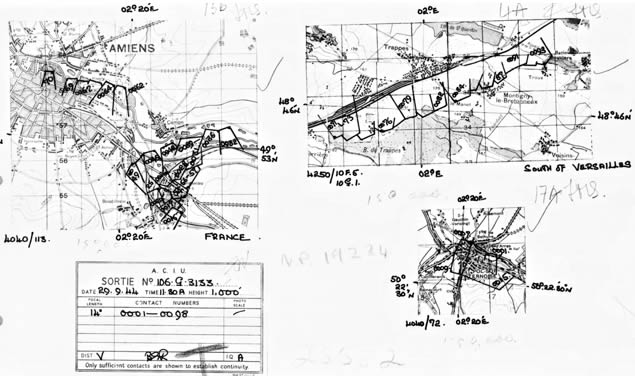In the days and weeks following the D-Day landings in Normandy, France, on 6 June 1944, Allied bomber forces ranged deep into occupied France, attacking lines of communication and supply. The Allies adoption of the Transport Plan led to railway junctions and marshalling yards being heavily bombed to prevent German reinforcements being sent to stem the Allied advance.
One of the key railway hubs targeted was at Amiens. The junction at Longueau, to the south-east of Amiens, escaped attack until the night of 12/13 June 1944 when 200 bombers were sent to destroy it. Aerial photographs taken during sortie 106G/3133 illustrate the effect of this attack.

Longueau Railway Depot
The locomotive maintenance and repair facility at Longueau sustained heavy damage from Allied bombing. This image also shows damage to the adjacent semi-roundhouse, turntable, marshalling yard and rolling stock.
|
 |
| This image shows a heavily damaged roundhouse, with several burnt-out locomotives and railway wagons present. One locomotive can be seen to have been blown back into the turntable by bomb blasts. |
 |
| Allied bombing caused heavy damage to the locomotive maintenance and repair facility at Longueau. Rolling stock in the adjacent sidings also suffered; this image shows fire and blast damaged box, open and flatbed rail wagons. |
 |
Longueau Marshalling Yard
This view of the marshalling yard at Longueau shows the devastation caused to rolling stock by Allied bombing. Light toned areas show where repairs have been made to damaged areas of track and rail bed.
|
 |
Longueau
Due to the difficulties involved in accurately bombing a target at night, the area around the Longueau railway junction received a number of bombs intended for the railway infrastructure. This image shows destroyed and damaged civilian housing adjacent to the railway.
|
 |
Amiens
A view south along the Boulevard d'Alsace Lorraine, Amiens, proceeding northwards along which is a column of Allied trucks. Some bomb damage to buildings is visible in the foreground.
|
 |
| The Cathedral Notre-Dame, Amiens, fills the upper left corner of this image. Areas of open ground on either side of the Rue Saint Leu testify to earlier bombing raids. Amiens was liberated on 31 August 1944, almost one month before the date of this photographic sortie. |
 |









